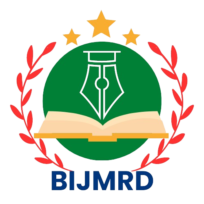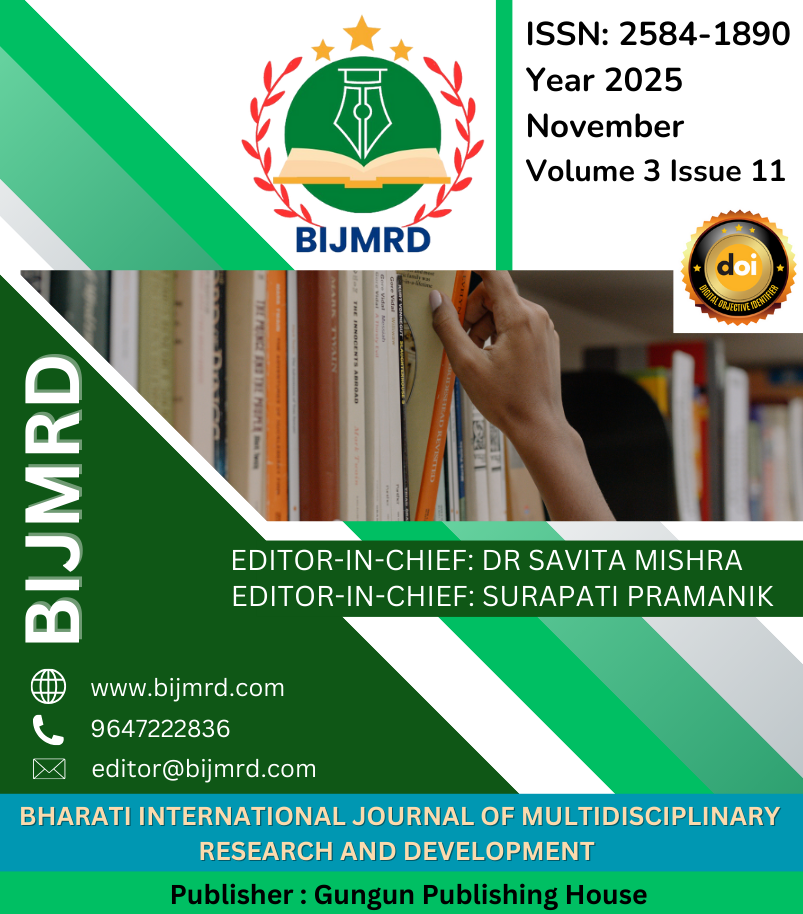Current Issue
Year 2025 - November | Volume -3 | Issue -11
Author: Shrabanti Garain
DOI Link: https://doi.org/10.70798/Bijmrd/03110001
Abstract: Elementary education is a foundation of education system. This foundation is built through providing proper education to children from initial stage. Also, golden cultures are necessary for making a good, responsible and self-reliant citizenship. Therefore, those golden cultures are nurtured and practiced among children at elementary level of education for developing the self -reliant citizenship. In this case, content analysis method is adopted for conducting this study. Moreover, different culture like culture of reading, culture of writing, culture of listening, culture of silence, culture of patience, culture of respect, culture of unfolding potential creativity, culture of humanity, culture of developing the positive attitude, culture of joyful learning, culture of life-long learning, culture of skills development and culture of balanced personality development are needed for developing the self -reliant citizenship.
Keywords: Golden Cultures, Self -reliant Citizenship and Elementary Level of Education.
Page No: 1-6
Author: Dr. Sristidhar Bera
DOI Link: https://doi.org/10.70798/Bijmrd/03110002
Abstract: The present study wants to investigate the impact of state trait anxiety on academic achievement of IX grade secondary school students of Paschim medinipur district in west Bengal, India. In this study researcher attempted to examine the co-relation between state trait anxiety and academic achievement of the respondent. Total sample was 79 from two Government aided Bengali medium Secondary School affiliated from west Bengal board of secondary education. A standardized questionnaire developed by Charles D. Spielberger et. al. was used to collect requisite data from the respondent using purposive sampling procedure. Descriptive statistical techniques were used to analyze the data like Mean, SD, and Correlation. After analyzing data the result showed that no significance relation exists between state trait anxiety and academic achievement of IX grade secondary students. About fifty percent student has high state trait anxiety. Friendly relationship, congenial learning environment, employing efficient teaching strategies, seminar, awareness programme, and teacher’s positive attitude will reduce students state trait anxiety.
Keywords: State Trait Anxiety, Trait Anxiety, Academic Achievement, Co-Relation.
Page No: 7-14
Author: Prakash Kumar Sahoo
DOI Link: https://doi.org/10.70798/Bijmrd/03110003
Abstract: The COVID-19 pandemic precipitated an unprecedented disruption in global education systems, necessitating a rapid shift from traditional classroom-based learning to online and remote education. This research article examines the transition to online education during the pandemic, exploring its implications on learners, educators, and educational institutions. The study highlights the opportunities, challenges, and limitations of this shift, with a focus on accessibility, engagement, and pedagogical effectiveness. Drawing on empirical studies, surveys, and institutional reports, the article analyzes how the pandemic has accelerated the adoption of digital learning technologies and reshaped educational paradigms. Key findings suggest that while online education has fostered flexibility and continuity, it has also exacerbated existing inequalities, posed technological challenges, and required significant adaptation by educators and learners alike. The article concludes by discussing strategies for optimizing online education post-pandemic and integrating digital learning into resilient, inclusive, and future-ready educational frameworks.
Keywords: COVID-19, Online Education, Digital Learning, Remote Learning, Educational Technology, Learning Outcomes, Accessibility.
Page No: 15-21
Author: Dr. Sathyadevan Sen
DOI Link: https://doi.org/10.70798/Bijmrd/03110004
Abstract: Physical activity is increasingly recognized as a key factor in supporting adolescents’ mental well-being and academic success. This study examines the relationship between physical activity participation, psychological health, and academic achievement among adolescents aged 13–18. A descriptive research method was adopted, and data were collected from 250 students through a standardized questionnaire. The findings indicate that regular engagement in physical activity contributes to reduced stress and anxiety, improved concentration, memory retention, and overall academic performance. However, sedentary behavior, screen dependency, and academic workload emerged as barriers. The study emphasizes the need for schools and families to promote active lifestyles as a contributing factor to both mental and academic development.
Keywords: Physical activity, Mental health, Academic performance, Adolescents, Stress reduction, Cognitive development.
Page No: 22-27
Author: Ujjwal Mistry
DOI Link: https://doi.org/10.70798/Bijmrd/03110005
Abstract: Sustainable Business Practices and Corporate Social Responsibility (CSR) have become essential components of modern organizational strategies. As businesses increasingly face environmental challenges and societal expectations, the focus has shifted from traditional profit-maximization to responsible and ethical operations. Sustainable business practices emphasize the efficient use of resources, reduction of environmental impact, and long-term economic viability, while CSR involves voluntary contributions toward social welfare, employee well-being, and community development. This abstract highlights the significance of integrating sustainability and CSR into business policies to enhance corporate reputation, ensure regulatory compliance, and promote sustainable development. It concludes that adopting these approaches enables organizations to create value not only for shareholders but also for society and the environment, thereby achieving a balanced and inclusive growth model.
Keywords: Social Responsibility, Businesses, Community Development, Environment, Sustainability and CSR.
Page No: 28-34
Author: Ms. T. Agnees Mary & Dr. A. Edward William Benjamin
DOI Link: https://doi.org/10.70798/Bijmrd/03110006
Abstract: This studyinvestigatedthe mental health among Bachelor of Education (B.Ed.) students and its variation across selected demographic variables in Tiruchirappalli district, Tamil Nadu. A sampleof 295 B.Ed.students was selected from different teacher education institutions using a stratified sampling approach. Mental health was assessed using a standardized mental health scale covering key dimensions such as academic stress management, self-esteem and confidence, emotional balance, and social adjustment. Descriptive statistics and t-test /ANOVA were used to analyse differences in mental health across gender, locality, type of institution and educational qualification. The findings indicated no statistically significant difference in overall mental health with respect to gender and locality. However, type of institution and educational qualification showed significant differences in some specific dimensions, particularly academic stress management and self-esteem and confidence. Students from certain institution types and with higher prior qualifications reported relatively better capacity to manage academic stress. The study highlights the need for targeted mental health support within teacher education programmes, with special attention to institutional climate, academic pressure and counselling services. Implications for teacher educators and policy makers are discussed.
Keywords: Mental Health; B.Ed. Students; Teacher Education; Academic Stress Management; Self-Esteem And Confidence.
Page No: 35-47
Author: Dr. R. Selvamani & Dr. R. Mangaleswaran
DOI Link: https://doi.org/10.70798/Bijmrd/03110007
Abstract: Artificial intelligence is reshaping rural development, yet youth impacts in India remain understudied. A systematic review and meta-analysis synthesized empirical studies on rural Indian youth. Methods followed PRISMA 2020 standards for transparent selection and reporting (Page et al., 2021). Outcomes covered leisure, mental health, education, gender attitudes, service use, and hygiene. Random-effects models aggregated standardized mean differences and assessed between-study heterogeneity. Educational and health knowledge showed large positive associations (d=0.77, p<1e-5). Gender and social attitudes displayed moderate positive associations (d=0.40, p<1e-5). Health and hygiene practices showed moderate gains (d=0.46, p<1e-5). Service use and violence outcomes showed negative associations (d=-0.38, p<1e5). Leisure and mental health exhibited small, nonsignificant changes (d=0.04, p=0.08). Associations favored cognitive and attitudinal domains over service engagement or safety behaviors. Results indicate correlations, not causes, and may reflect access barriers or disparities. Policy design should strengthen beneficial domains while addressing service uptake challenges. Evidence provides a structured basis for evaluating AI within rural socio-economic change.
Keywords: Artificial Intelligence, Rural Youth Development, Knowledge Outcomes, Gender Attitudes, Service Barriers.
Page No: 48-60
Author: Mohammad Razzaque & Samiran Mondal
DOI Link: https://doi.org/10.70798/Bijmrd/03110008
Abstract(सारांश): शांतिनिकेतन और उसके आसपास के इलाक़ों में स्थित प्राचीन टेराकोटा (पक्की मिट्टी की) मंदिर सिर्फ़ धार्मिक आस्था के केंद्र नहीं हैं, बल्कि वे अपने समय के समाज, जीवनशैली और लोक परंपराओं के सजीव दस्तावेज़ भी हैं। इस शोध का उद्देश्य यह समझना है कि इन मंदिरों की दीवारों पर बने योग (योगासन), व्यायाम (शारीरिक कसरत), और क्रीड़ा (खेलकूद) से जुड़े चित्र किस प्रकार से उस समय के लोगों की सोच, उनकी दिनचर्या और सामुदायिक जीवन को दर्शाते हैं।
मैंने शांतिनिकेतन के आसपास स्थित प्रमुख मंदिरों — जैसे सुरुल सरकार बड़ी, मानसामंदिर, इलमबाज़ार के पाँच मंदिर, श्रीनिकेतन का लक्ष्मी-जनार्दन मंदिर और घुड़िसा मंदिर — का प्रत्यक्ष दौरा किया। वहाँ पर मैंने न केवल चित्रों का अध्ययन किया बल्कि स्थानीय लोगों, श्रद्धालुओं और मंदिर से जुड़े बुज़ुर्गों से बातचीत भी की। उनसे मिली मौखिक जानकारी, परंपराएँ और उनकी यादें इस शोध का एक महत्वपूर्ण हिस्सा बनीं।
इन मंदिरों की टेराकोटा कला में कुश्ती, तीरंदाज़ी, ध्यान की मुद्रा, घुड़सवारी, और बच्चों के खेल जैसी अनेक गतिविधियाँ दिखती हैं। ये सिर्फ़ सजावट नहीं, बल्कि एक ज़माने की जीवनशैली की झलक हैं। यह शोध इस बात को रेखांकित करता है कि भारतीय समाज में शारीरिक और मानसिक विकास को किस तरह से धार्मिक और सांस्कृतिक जीवन का अभिन्न हिस्सा माना जाता है।
इन मंदिरों और उनके चित्रों को न सिर्फ़ संरक्षण की ज़रूरत है, बल्कि इन्हें समझना, दस्तावेज़ करना और आने वाली पीढ़ियों तक पहुँचाना हमारी सांस्कृतिक ज़िम्मेदारी भी है।
Keywords(मुख्य शब्द): शांतिनिकेतन, टेराकोटा मंदिर, योग, व्यायाम, क्रीड़ा, लोक कला, सांस्कृतिक अभिव्यक्ति, बंगाल की विरासत, शारीरिक संस्कृति, मंदिर शिल्प
Page No: 61-77
Author: মৌসুমী মাজি
DOI Link: https://doi.org/10.70798/Bijmrd/03110009
Abstract(সারসংক্ষেপ): “তুলনামূলক আলোচনার আয়নায় রবীন্দ্রনাথ ও নজরুলের সঙ্গীতধারা: সুর, চেতনা ও দর্শনের অনুসন্ধান” প্রবন্ধটি বাংলা সঙ্গীতের দুই শিখর ব্যক্তিত্ব—রবীন্দ্রনাথ ঠাকুর ও কাজী নজরুল ইসলামের সৃষ্টিশীল ধারা, তাদের সুরলহরী, ভাব-চেতনা ও দার্শনিক অন্তর্গত মানসকে এক তুলনামূলক পরিসরে বিশ্লেষণ করে। রবীন্দ্রসঙ্গীত যেখানে প্রকৃতি, মানবতা, ভক্তি ও চিরন্তন সৌন্দর্যবোধের সাযুজ্যে অন্তর্মুখী মাধুর্য সৃষ্টি করে, সেখানে নজরুলগীতি মুক্তির আকাঙ্ক্ষা, বিদ্রোহী চেতনা ও মানবপ্রেমের জাগ্রত স্পন্দনে বহির্মুখী প্রেরণার আকার ধারণ করে। উভয়ের সঙ্গীতে ভারতীয় রাগসঙ্গীতের ঐশ্বর্য এবং পাশ্চাত্য সংগীতপ্রভাবের মৌলিক সম্মিলন ঐতিহ্যের ধারাবাহিকতাকে নতুন আঙ্গিকে পুনঃনির্মাণ করেছে। প্রবন্ধটির উদ্দেশ্য হলো রবীন্দ্রনাথ ও নজরুলের সুরসৃষ্টির আধ্যাত্মিক ভিত্তি, সামাজিক প্রেরণা ও নান্দনিক দর্শনকে আলোচনায় এনে আধুনিক বাংলা সংগীতধারার বিবর্তনকে নতুন দৃষ্টিকোণ থেকে অনুধাবন করা। এই তুলনামূলক অন্বেষণ বাংলা সঙ্গীতের সার্বজনীন রূপকে বিশ্লেষণ করার এক মূল্যবান প্রয়াস।
Keywords(সূচক শব্দ): রবীন্দ্রসঙ্গীত, নজরুলগীতি, সঙ্গীতদর্শন, জাতীয় চেতনা, মানবতাবাদ, রাগসঙ্গীত ও পাশ্চাত্য প্রভাব, তুলনামূলক সঙ্গীত বিশ্লেষণ।
Page No: 78-84
Author: R. Sheela, Dr. B. Saminathan & Dr. A. Edward William Benjamin
DOI Link: https://doi.org/10.70798/Bijmrd/03110010
Abstract: In an era characterized by pervasive digital interconnectivity, social media has evolved into a primary medium for emotional expression, interpersonal communication, and academic engagement particularly among pre-service teachers navigating emotionally demanding educational settings. This quantitative correlational study investigates the role of Social Media Emotional Intelligence (SMEI) defined as the ability to perceive, understand, and manage emotions within online environments in predicting psychological wellbeing and academic performance among student teachers. A total of 100 student teachers enrolled in accredited teacher education programs participated in the study. Standardized instruments were utilized, including the Social Media Emotional Intelligence Scale (SMEIS), the Ryff Psychological Well-Being Scale, and self-reported academic performance metrics verified through institutional records. Data were analysed using Pearson’s correlation and multiple regression analyses to determine the predictive relationship between SMEI dimensions (emotional perception, expression, regulation, and empathy) and the outcome variables. Findings revealed that SMEI demonstrated a positive and significant correlation with both wellbeing (r = .63, p < .01) and academic performance (r = .48, p < .01). Regression analysis indicated that emotional regulation and online empathy emerged as the strongest predictors of well-being, whereas emotional expression significantly predicted academic success. These results underscore the critical role of digital emotional competence in shaping student teachers’ holistic development. Integrating digital emotional literacy within teacher education curricula can enhance emotional resilience, promote psychological well-being, and support academic excellence in digitally mediated learning environment.
Keywords: Social Media Emotional Intelligence, Emotional Regulation, Well-Being, Academic Performance, Student Teachers, Digital Literacy, Emotional Competence.
Page No: 85-93


